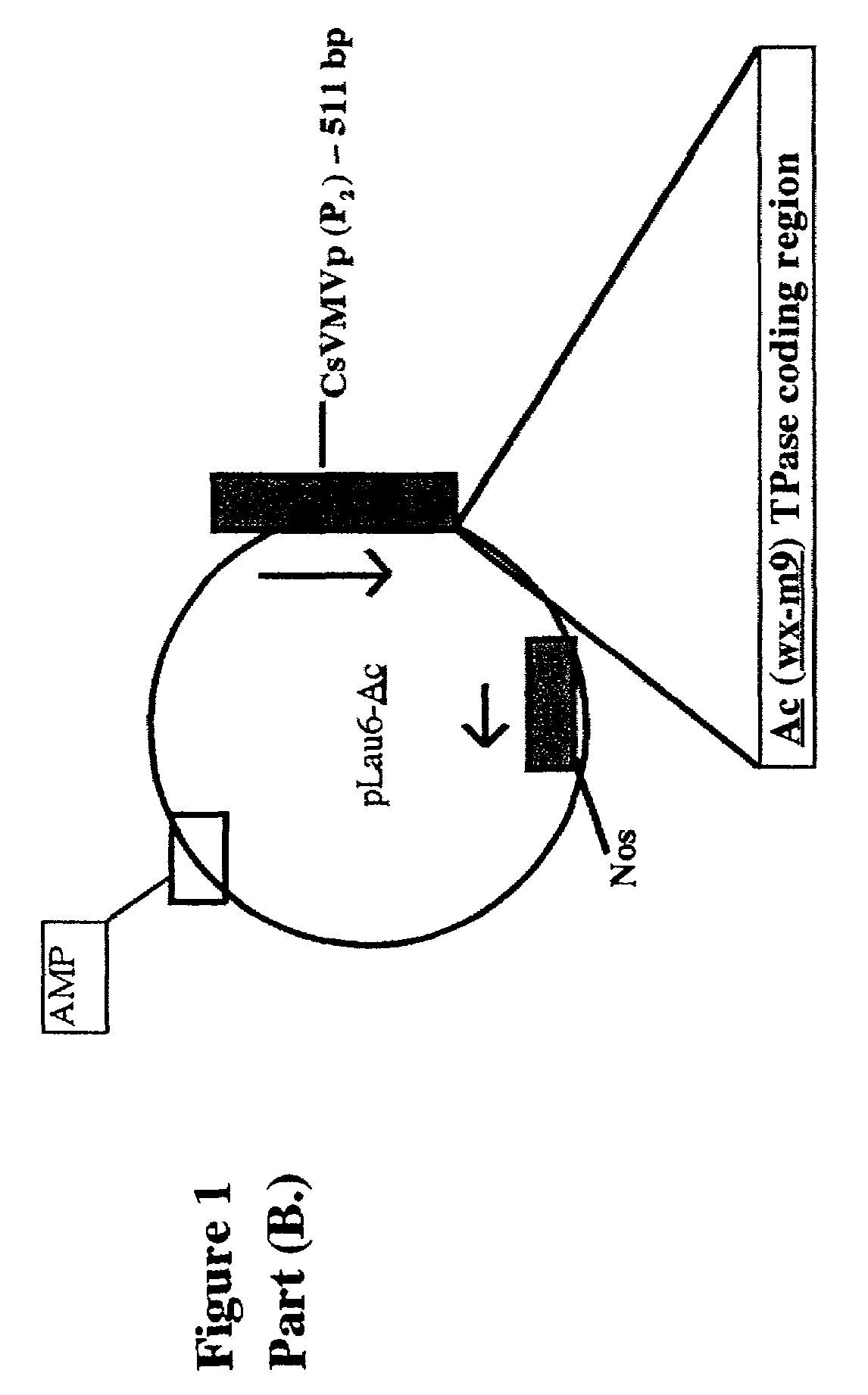Use of transposable elements for altering gene expression
a technology of transposable elements and gene expression, which is applied in the field of altering gene expression using transposons, can solve the problems of not all maize lines contain active ac elements capable of transposition, and the effect of non-transposable elements (i.e., plant gene or animal gene) promoters cannot be expected from those data
- Summary
- Abstract
- Description
- Claims
- Application Information
AI Technical Summary
Benefits of technology
Problems solved by technology
Method used
Image
Examples
example 1
Demonstration of an Ac TPase-induced Gene Repression Effect in a Plant Cell System
Materials and Methods
[0374]Generation of the gusA Reporter, Ac Effector, and pUC18 Effector Constructs Used
[0375]i. Reporter Constructs
[0376]The two gusA expression vector constructs (reporters) are called “T1R−90-GUS” and “−90-GUS”. They contain the CaMV 35S −90 native promoter region (Benfey et al., 1990a,b) a promoter which includes 5 copies on either strand of the minimal triplet sequences present within Ac element terminii and known to be involved in binding of the maize Ac element transposase (triplets: 5′ ACG 3′ or 5′ TCG 3′; FIG. 3; Becker and Kunze, 1997). In addition, the “T1R−90-GUS” construct contains 1 repeat copy (T1R) of the Ac hexamer (5′ AAACGG 3′) (which binds strongly to the Ac transposase; FIG. 1A). These two
[0377]Following amplification, products of the predicted sizes were excised and purified from 2.3% agarose using the “Mermaid” DNA purification kit (Bio101 / Quantum Biotechnologi...
example 2
Cloning and Expression of the Maize Ac TPase in Saccharomyces cerevisiae
[0430]Two 30 bp PCR primers were designed so as to amplify the 3.1 kb maize Ac TPase coding region out of a vector construct called pLau6-Ac (see Example 1 for a description of this maize genomic clone construct). These primers have the sequence primer 1: 5′ GGAACCCG-GATCCCACTTCGGCTAGCCGGC 3′ (SEQ ID NO:4). primer 2: 5′ GGAACCCG-GATCCACCAAGGCTCATCTGTC 3′ (SEQ ID NO:5). A 7-bp buffer seq. is italicized and a BamHI site is underlined. The BamH1 cutting site is shown by a dash.
[0431]Each of the two PCR primers above contains a 7-base restriction enzyme buffer sequence (many restriction enzymes cleave better, if their cutting site is flanked by greater than 1 DNA base), and also a BamHI restriction enzyme recognition site.
[0432]Using the above primers, the Ac TPase was amplified from pLau6-Ac by standard methods. The amplified TPase gene was then digested with BamH1. A yeast plasmid vector, pYES2 / NT-A (Invitrogen) ...
PUM
| Property | Measurement | Unit |
|---|---|---|
| total volume | aaaaa | aaaaa |
| pH | aaaaa | aaaaa |
| environmental stress | aaaaa | aaaaa |
Abstract
Description
Claims
Application Information
 Login to View More
Login to View More - R&D
- Intellectual Property
- Life Sciences
- Materials
- Tech Scout
- Unparalleled Data Quality
- Higher Quality Content
- 60% Fewer Hallucinations
Browse by: Latest US Patents, China's latest patents, Technical Efficacy Thesaurus, Application Domain, Technology Topic, Popular Technical Reports.
© 2025 PatSnap. All rights reserved.Legal|Privacy policy|Modern Slavery Act Transparency Statement|Sitemap|About US| Contact US: help@patsnap.com



